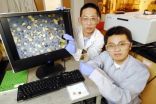(Press-News.org) BOSTON – The discovery that a protein called Rictor plays a key role in destroying a close cousin of the AKT oncogene could provide scientists with a new molecular target for treating certain cancers, including breast cancer. Described in the September 2010 issue of the journal Molecular Cell, the study was led by scientists at Beth Israel Deaconess Medical Center (BIDMC).
The oncogenic cousin, known as SGK1, resembles the widely known AKT oncogene in structure, according to the study's senior author Wenyi Wei, PhD, of the Department of Pathology at BIDMC and Assistant Professor of Pathology at Harvard Medical School (HMS).
"If we put the two proteins together, they are very similar," explains Wei. "But in one important way they are very different. AKT is stable, it lives for a long time. But SGK1 has a very short lifespan, and proteins with short lifespans tend to be powerful. Everybody's eye [has been] on AKT, but you have to wonder if this little cousin of AKT can do all the things AKT does." Wei and his team, therefore, set out to better understand how cells control SGK1.
Previous research showed that the protein Rictor forms a multi-protein complex called mTORC2 that activates both AKT and SGK1. Wei's team cultured cells lacking Rictor to observe the effect on SGK1. Surprisingly, they found that SGK1 levels increased.
"We said, that cannot be," notes Wei. "How could we get rid of the protein kinase that activates SGK1 and still have the SGK1 levels be heightened?"
They found their answer when they observed that the cells weren't producing more SGK1; rather, SGK1 was living longer. This suggested to the scientists that Rictor might be playing a role in the destruction of SGK1. And, in subsequent experiments, Wei found that SGK1 is indeed held in check by a protein complex made up of Rictor, Cullin-1, Rbx1, and possibly other components. The protein complex forms a cellular garbage collector called an E3 ligase that degrades SGK1 so it cannot build up.
"The protein Rictor is modular and multifunctional," said Wei. "Its function depends on its partners." This observation suggests that some proteins may act like a central machine that can work with a variety of attachments, the same way a construction vehicle can change its function depending on whether it's wielding a bulldozer or a crane. "With further study," he adds, "we may find more proteins [like Rictor] that have multiple functions. When a cell makes a protein this big, isn't it a waste of energy to have only one function?"
Wei's team further observed that once SGK1 begins to accumulate, it turns right around and interrupts the Rictor-Cullin1 complex, stifling it's garbage collection activities. "It looks like a positive feedback loop that serves to increase SGK1," says Wei.
"The novelty and significance of this work lies in the discovery of a role for Rictor in destroying SGK1, a key regulator of cell growth and cell death that is frequently associated with human cancers," said Marion Zatz, PhD, who manages cell cycle grants at the National Institutes of Health (NIH). "The finding suggests that faulty regulation of Rictor may play a part in some forms of cancer, and could offer us a new target for treating the disease."
While the exact role of SGK1 in tumor growth isn't yet clear, Wei speculates that SGK1 may play a role in cancer by hijacking a cell's metabolism, just as its close cousin AKT does. "This mechanism we discovered may be part of what drives overexpression of SGK1," he adds.
INFORMATION:
This study was supported, in part, by grants from the National Institutes of Health and by a DOD Prostate New Investigator Award to Wenyi Wei. Wei is a Kimmel Scholar, V Scholar and Karin Grunebaum Cancer Research Foundation Fellow.
Study coauthors include BIDMC investigators Daming Gao (first author), Lixin Wan, Hiroyuki Inuzuka, Anders Berg, Alan Tseng, Shavali Shaik, Jessica Gasser and Alex Toker; Bo Zhai, Steven Gygi, Eric Bennett, and J. Wade Harper of Harvard Medical School; and Adriana Tron and James DeCaprio of the Dana-Farber Cancer Institute.
Beth Israel Deaconess Medical Center is a patient care, teaching and research affiliate of Harvard Medical School and consistently ranks in the top four in National Institutes of Health funding among independent hospitals nationwide. BIDMC is a clinical partner of the Joslin Diabetes Center and a research partner of the Harvard/Dana-Farber Cancer Center. BIDMC is the official hospital of the Boston Red Sox. For more information, visit www.bidmc.org.
Rictor protein offers scientists a new molecular target for cancer therapies
2010-10-29
ELSE PRESS RELEASES FROM THIS DATE:
Insulin-creating cell research may lead to better diabetes treatment
2010-10-29
LIVERMORE, Calif. – Beta cells, which make insulin in the human body, do not replicate after the age of 30, indicating that clinicians may be closer to better treating diabetes.
Type 1 diabetes is caused by a loss of beta cells by auto-immunity while type 2 is due to a relative insufficiency of beta cells. Whether beta cells replicate after birth has remained an open issue, and is critically important for designing therapies for diabetes.
By using radioactive carbon-14 produced by above-ground nuclear testing in the 1950s and '60s, researchers have determined that the ...
Organic solvent system may improve catalyst recycling and create new nanomedicine uses
2010-10-29
Noble metals such as platinum and palladium are becoming increasingly important because of growth in environmentally friendly applications such as fuel cells and pollution control catalysts. But the world has limited quantities of these materials, meaning manufacturers will have to rely on efficient recycling processes to help meet the demand.
Existing recycling processes use a combination of two inorganic acids known as "aqua regia" to dissolve noble metals, a class of materials that includes platinum, palladium, gold and silver. But because the metals are often dissolved ...
A recent IRCM breakthrough impacts cancer research
2010-10-29
Montreal, October 28, 2010 – A team of scientists at the Institut de recherches cliniques de Montréal (IRCM) led by Dr. Jean-François Côté, Director of the Cytoskeletal Organization and Cell Migration research unit, identified a novel molecular mechanism in the control of cell motility. Their findings were published online today in Current Biology, a journal from the Cell Press group. This scientific breakthrough could eventually lead to the development of new cancer-treating drugs that could block the spread of tumours (metastasis).
"As many as 90% of cancer patient ...
Spacecraft will enable scientists to study space environment around moon, Earth
2010-10-29
Two spacecraft are now beginning to study the moon's environment as part of NASA's ARTEMIS mission, whose principal investigator is Vassilis Angelopoulos, a UCLA professor of Earth and space sciences.
One of these satellites has been in the lunar environment since Aug. 25, and the second arrived Oct. 22, marking the start of the ARTEMIS mission to gather new scientific data in the sun-Earth-moon environment.
ARTEMIS is an acronym for Acceleration, Reconnection, Turbulence and Electrodynamics of the Moon's Interaction with the Sun.
For roughly six months, the ...
Immigrant Latinos in rural Illinois have unique child care needs
2010-10-29
URBANA – Finding good child care and being able to engage easily in important interactions with your child care provider are critical to any mother's ability to work outside the home.
"Suppose you're living in the rural Midwest and you don't speak English very well. Can you imagine leaving your child with a child care provider if you couldn't communicate well with that person?" said Angela Wiley, a University of Illinois associate professor of applied family studies.
"The immigrant moms we interviewed for this study faced just this dilemma," she said.
Immigrant Latino ...
Newly discovered regulatory mechanism essential for embryo development and may contribute to cancer
2010-10-29
Researchers from Mount Sinai School of Medicine have identified a mechanism controlling the function of a protein that binds to DNA during embryonic development and may function to prevent abnormal tumor growth. When the protein, TCF3, is modified by a small molecule called a phosphate, it no longer binds DNA, changing the way the protein signals during development. This discovery identifies a new diagnostic marker (phosphorylated TCF3) that may be associated with cancer and could represent a potential drug target. The results are published in the current issue of Developmental ...
UM researchers are studying child-mother interactions to design robots with social skills
2010-10-29
CORAL GABLES, FL (October 28, 2010)—To help unravel the mysteries of human cognitive development and reach new the frontiers in robotics, University of Miami (UM) developmental psychologists and computer scientists from the University of California in San Diego (UC San Diego) are studying infant-mother interactions and working to implement their findings in a baby robot capable of learning social skills.
The first phase of the project was studying face-to-face interactions between mother and child, to learn how predictable early communication is, and to understand what ...
Wild Scottish sheep could help explain differences in immunity
2010-10-29
Strong immunity may play a key role in determining long life, but may do so at the expense of reduced fertility, a Princeton University study has concluded.
An 11-year study of a population of wild sheep located on a remote island off the coast of Scotland that gauged the animals' susceptibility to infection may give new insight into why some people get sicker than others when exposed to the same illness.
The answer to this medical puzzle may lie in deep-rooted differences in how animals survive and reproduce in the wild, according to the study, which was led by Princeton ...
Phosphorus identified as the missing link in evolution of animals
2010-10-29
A University of Alberta geomicrobiologist and his PhD student are part of a research team that has identified phosphorus as the mystery ingredient that pushed oxygen levels in the oceans high enough to establish the first animals on Earth 750 million years ago.
By examining ancient-ocean sediments, Kurt Konhauser, student Stefan Lalonde and other colleagues discovered that as the last glacier to encircle Earth receded, leaving behind glacial debris containing phosphorus that washed into the oceans. Phosphorus is an essential nutrient that promoted the growth of cyanobacteria, ...
People with specific kind of lung cancer respond to new targeted treatment
2010-10-29
AURORA, Colo. (Oct. 28, 2010) - A study in the New England Journal of Medicine shows more than half of patients with a specific kind of lung cancer are responding positively to a treatment that targets the gene that drives their cancer.
The study shows 57 percent of patients with ALK-positive advanced non-small cell lung cancer responded partially or completely to a tablet called crizotinib, an investigational anaplastic lymphoma kinase (ALK) inhibitor. In some cases, the cancer becomes undetectable in body scans. The data is published in the October 28 issue of the ...

